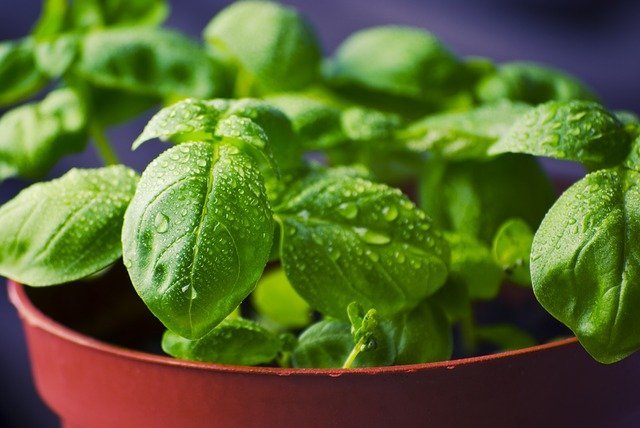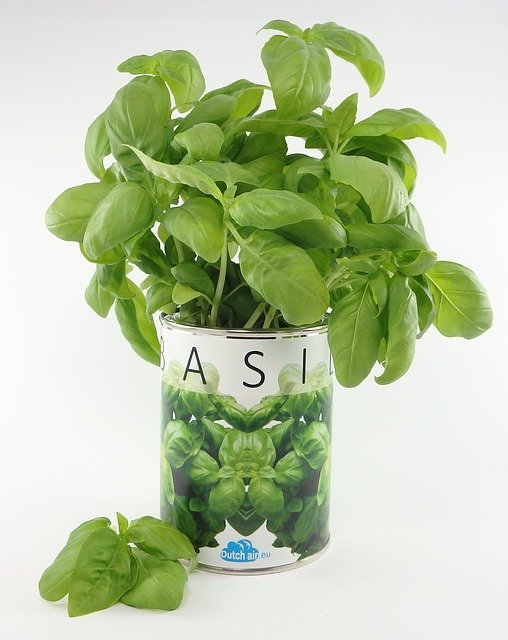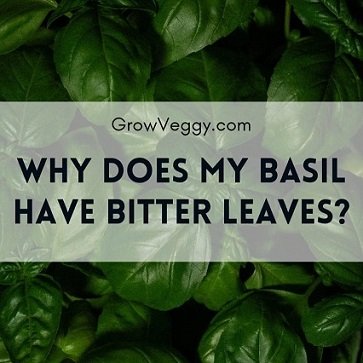When it comes to taste, nobody wants strong, bitter-tasting basil.
Basil leaves can turn bitter for many reasons like flowering, harsh sunlight, overwatering, underwatering, basil type, etc.
Let us look at these causes in detail and the simple ways with which you can fix your plant.
Is basil a bitter herb?
Basil is an aromatic herb belonging to the mint (Lamiaceae) family. Though well-known for its sweet-tasting leaves, the basil plant also comes in a few varieties (ex. purple basil) that are relatively bitter in taste.
Other than that, there are a few factors that can make the taste of basil bitter.
Causes for basil leaves turning bitter
Here are a few causes that turn your basil plant leaves bitter.
1) Flowering
Basil flowers look pretty and are often used as a garnish, but once the plant starts flowering, basil loses its flavor.
Basil is an annual herb. At the end of their life cycle, they start to flower and the flowers generate new seeds. After this, the plant dies as a part of its natural life process.
Basil plant peaks right before it bloom, with the maximum content of oil and the best flavor.
As soon as the seeds start flowering, the plant turns its attention to the flowers and seeds, spending less energy on the rest of the parts.
As a result, the older leaves start wilting and the leaf production stops. The leaves that grow after this are smaller in size and bitter to taste.
2) Variety
With over 60 varieties of basil all over the world, the reason for bitter basil leaves can also be contributed to the variety of basil plants you have.
The flavors of different varieties of basil range from sweet to spicy to acidic to bitter. It is possible that the plant in your house belongs to the bitter variety, which would naturally make the leaves taste bitter.
For example, the purple basil will have a slightly bitter taste than the sweet basil, or the Genovese basil, which are the varieties most commonly used in cooking.
3) Harvest time
The time of your harvest also plays an important role in the flavor of your basil. It is ideal that you harvest the basil leaves in the morning after the dew has dried.
Dampness will result in reduced essential oil production.
Harvesting later in the day can also bring about a change in the flavors and aroma of the basil. Wind and heat dissipate the essential oils. This naturally leads to a dull flavor that can turn sour or bitter.
The flavor also continues to change after you cut the leaves.
4) Growing conditions
The growing conditions of basil, such as the soil, climate, and region also play an important role in the taste of the basil plant. If you play around with any of the set factors, you are going to get very different results in terms of the flavor of the basil.
Basil needs well-drained and moist soil along with a lot of sunlight in order to grow well. Changes in either will immediately show results.
5) Overwatering or Under-watering
Overwatering or under-watering the basil can also cause bitterness in the leaves. Basil is a very sensitive herb, and it has very specific water requirements. Too much water or too little water will immediately show results in the way it grows.
6) Heat
Heat will definitely bring about a change in the taste of the basil as Heat makes basil taste more bitter.
This includes heat in all forms: be it harsh sunlight, the heat while cooking food, or even the heat caused by friction in the blades of a food processor. Any type of heat will change the taste of basil and make it slightly bitter.
Even cooking basil for too long can make it bitter. This is the reason why a lot of the recipes that use basil leaves do not use cooked basil.
7) Incorrect storage
How you store the basil will also determine its flavor.
Usually, storage for a long time will most likely result in a loss of flavor and essential oils. If you keep your basil stored for too long, it will change the flavor.
While most herbs keep well for 2 to 3 weeks when kept between 32 to 41 degrees Fahrenheit, basil is sensitive to the cold.
Basil needs temperatures above 50 degrees Fahrenheit to stay good. And still, after 1 to 2 weeks, it will turn sour.
If you do want to store it, you should keep basil stems in water.

How to Prevent Bitter Leaves?
Here are simple some ways with which you can protect your basil from turning bitter.
a. Pruning
Lack of pruning and letting it bloom is the primary reason for the basil leaves turning bitter.
A healthy, bushy plant requires regular pruning. Further, Pruning prevents the plant from flowering.
As the basil turns bitter due to its flowers, stopping the growth of the flowers by pinching it off at the first sign will make sure that your plant does not bloom, and hence you prevent the basil from turning bitter.
If you allow the flowers to bloom, the plant discontinues the process of growing leaves and comes closer to the end of its life cycle. Pruning not only prevents the growth of bitter leaves and helps retain flavor, but it also prolongs the life of the plant.
You can either keep pinching off just the flowers or resort to aggressive pruning. Aggressive pruning can help in the growth of better foliage.
You can cut off up to one-third of the plant. However, cutting down too much can cause stunted growth and poor functioning.
Pruning can be done every 3 to 4 weeks, depending on the growth of your basil, as basil grows fairly quickly.
When you are pruning, take care to cut it just above the lowest 3 or 4 leaves. A pruned plant not only looks better but also yields better produce.
b. Timing of Harvest
To get the best flavor from your basil, it is important to time your harvest correctly.
Harvesting the stems on a calm dry morning will ensure that the basil retains its flavors. The morning dew can create a damp atmosphere which could mess with the flavor, so make sure that the dew dries completely before you harvest the plant.
As much as possible, cut only as much as you need. This is because the flavors will change after you cut it, and all the extra basil will eventually lose flavor if kept stored and unused for a long time.
c. Caring for the plant
The plant needs proper care to grow healthy keeping its rich flavor and aroma.
It requires plenty of sunlight. It needs to be watered consistently so that it remains moist but well-drained. Rich soil can do wonders for basil.
Apart from this, some organic fertilizer every now and then can go a long way in preserving the flavor of your basil.
d. Storing it right
Basil is very hard to store properly for a long time regardless of your efforts. So it is best to use harvest as much basil as you need.
No matter how well you preserve it, harvested basil will lose its flavor after a while. Fresh basil is always better than dried basil.
However, if you do harvest basil and you do not want to use it straight away, it is recommended that you put the stems in the water as you would do with cut flowers. Cover them with plastic to retain the sweet flavor.
Even if you freeze basil, it will last only for about a week or two before turning sour, as basil requires sunlight.

Can you make the bitter leaves better after flowering?
If you are in a situation where flowers have blossomed and seeds have grown, will pruning the basil plant fix the bitter leaves.
Sadly No, once the flowers have blossomed and seeds have been produced, the basil has completed its life and will slowly turn woody and then die. At this stage, it is not possible to reverse the process.
Let us take another situation when flower buds have just come out and you have pruned the plant.
There are high chances are that new leaves will be tasty and not bitter.
Here are some tips that you can follow.
- The Sooner you have pruned your plant, the higher the chances for recovery.
- Prune the branches to the point where only a couple of the lowest leaves are left.
- In situations, where you may not be available to prune in time, w would recommend you hard prune the basil so that flowering would not happen till you come back.
- Attempt regular pruning of basil every 2 – 3 months to increase the longevity of the plant.
Why are there ants on my basil plant and how you can get rid of them?
How can you use bitter basil?
Once the leaves have turned bitter, you cannot reverse the process, but you can still use the bitter Basil in growing new plants.
– Propagating new Plants
One good way to maximize the use of bitter basil is by growing plants from seeds instead of propagating basil from cuttings.
- If you have not tried to reverse the flowering process by pruning them in time, there are going to be many flowers on the plant on many stems.
- In this case, propagating by using cuttings may not work. The better way would be to let the flowers complete their development. Soon they will start turning brown and dry.
- At this point, the seeds inside the flowers can be removed to be planted in a new pot to grow a new plant. The seeds are not difficult to identify.
- Once you have harvested the seeds, you can plant them and if you are not planning to plant them straight away, it is better to keep them in an airtight condition in a dry and dark place.
- You can even put them in the freezer to kill off any insects that could be on the seeds.
– Using Basil for culinary purposes
Though the leaves have turned bitter, they are safe for eating. Everyone has different taste buds so some may like the bitter taste of leaves.
- You can use as much basil as possible for immediate cooking.
- The rest of the leaves can be stored for use later. Ideally, the stems can be kept in water for a few days.
Can You Use Bitter Leaves For Pesto?
Technically yes, you can use bitter basil leaves for Pesto and it is safe to eat. Though we do not recommend the same as it can change the flavor. A few tips that can help to counteract the bitterness of basil are
- You can add a sweet ingredient like sugar or honey to balance the bitterness. Vinegar, salt, or chicken stock can also help in reducing the bitter taste in the food and bring a balance in flavors.
- Blanching (scalding vegetables in boiling water or steam for a short time) increases, the life of your herbs and vegetables. Along with this, it also reduces the bitterness of your basil.
- A change in the proportion of other ingredients, like doubling the number of greens, or increasing the other ingredients to balance the flavor can help to counter the bitterness of the basil.
FAQs
A change in the flavor of the basil will not alter its safety. Basil has many medicinal benefits. Even if the leaves do turn bitter, the basil is still safe to eat.
Basil leaves are susceptible to heat. So cooking them for a long time would change the taste. That is why you will find that in many recipes Basil leaves are used at the end or just as a garnish.

